CHEVROLET CAMARO 1994 4.G Owners Manual
Manufacturer: CHEVROLET, Model Year: 1994, Model line: CAMARO, Model: CHEVROLET CAMARO 1994 4.GPages: 292, PDF Size: 15.35 MB
Page 221 of 292
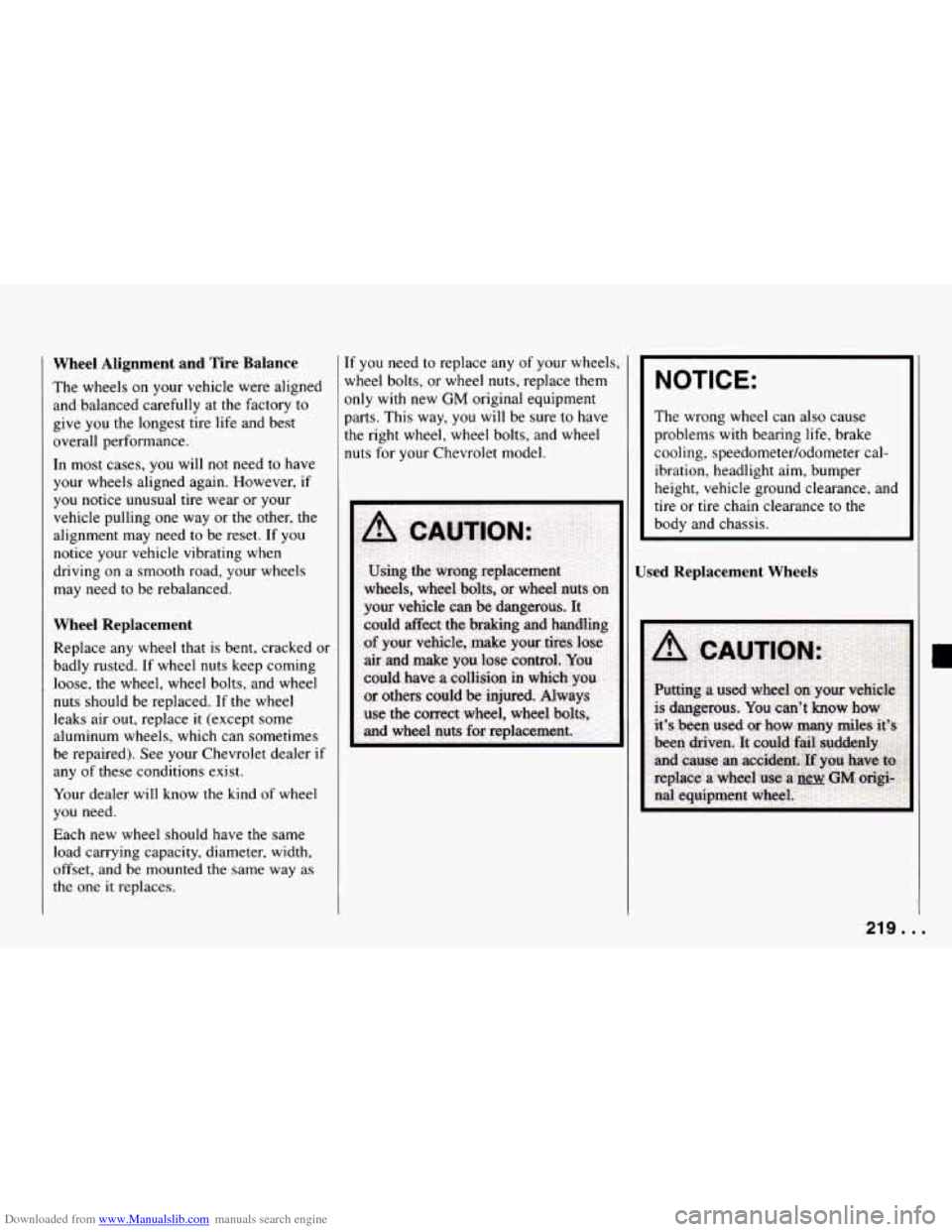
Downloaded from www.Manualslib.com manuals search engine Wheel Alignment and Tire Balance
The wheels on your vehicle were aligned
and balanced carefully at the factory to
give
you the longest tire life and best
overall performance.
In most cases, you will not need to have
your wheels aligned again. However,
if
you notice unusual tire wear or your
vehicle pulling one way or the other,
the
alignment may need to be reset. If you
notice your vehicle vibrating when
driving on a smooth road, your wheels
may need to be rebalanced.
Wheel Replacement
Replace any wheel that is bent, cracked or
badly rusted.
If wheel nuts keep coming
loose,
the wheel, wheel bolts, and wheel
nuts should be replaced. If the wheel
leaks air out, replace
it (except some
aluminum wheels, which can sometimes
be repaired). See your Chevrolet dealer
if
any of these conditions exist.
Your dealer will know
the kind of wheel
you need.
Each new wheel should have the same
load carrying capacity, diameter, width,
offset, and be mounted the same way as
the one it replaces.
[f you need to replace any of your wheels,
wheel bolts, or wheel nuts, replace them
Drily with new GM original equipment
parts. This way, you will be sure to have
the right wheel, wheel bolts, and wheel
nuts for your Chevrolet model.
NOTICE:
The wrong wheel can also cause
problems with bearing life, brake
cooling, speedometer/odometer cal-
ibration, headlight aim, bumper
height, vehicle ground clearance, and
tire or tire chain clearance to the
body and chassis.
Used Replacement Wheels
219..
Page 222 of 292
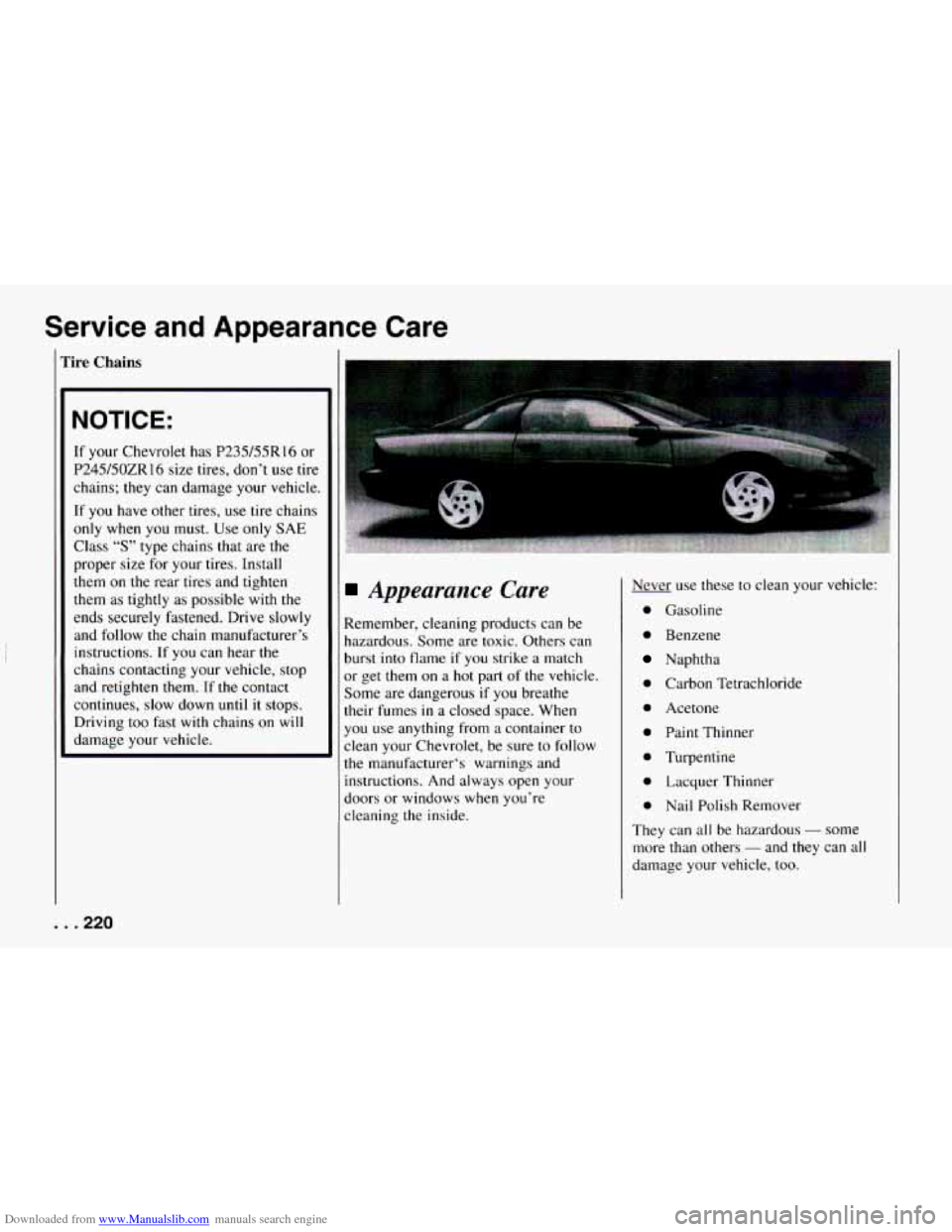
Downloaded from www.Manualslib.com manuals search engine Service and Appearance Care
rire Chains
NOTICE:
If your Chevrolet has P235/55R16 or
P245/50ZR16 size
tires, don’t use tire
chains; they can damage your vehicle.
If you have other tires, use tire chains
only when you must. Use only
SAE
Class “S” type chains that are the
proper size for your tires. Install
them on the rear tires and tighten
them as tightly
as possible with the
ends securely fastened. Drive slowly
and follow the chain manufacturer’s instructions. If you can hear the
chains contacting your vehicle, stop
and retighten
them. If the contact
continues, slow down
until it stops.
Driving too fast
with chains on will
damage your vehicle.
Rt
ha
bl
SC
th
Y(
cl
or
Appearance Care
:member, cleaning products can be
.zardous. Some are toxic. Others can
lrst into flame
if you strike a match
. get them on a hot part of the vehicle.
]me are dangerous
if you breathe
eir fumes
in a closed space. When
)u use anything from a container to
ean your Chevrolet, be sure to follow
the manufacturer‘s warnings and
instructions. And always open your
doors or windows when you’re
:leaning the inside. Never use these to clean your vehicle:
0 Gasoline
0 Benzene
Naphtha
0 Carbon Tetrachloride
0 Acetone
0 Paint Thinner
0 Turpentine
a Lacquer Thinner
0 Nail Polish Remover
They can
all be hazardous - some
more than others
- and they can all
damage your vehicle, too.
. . .220
Page 223 of 292
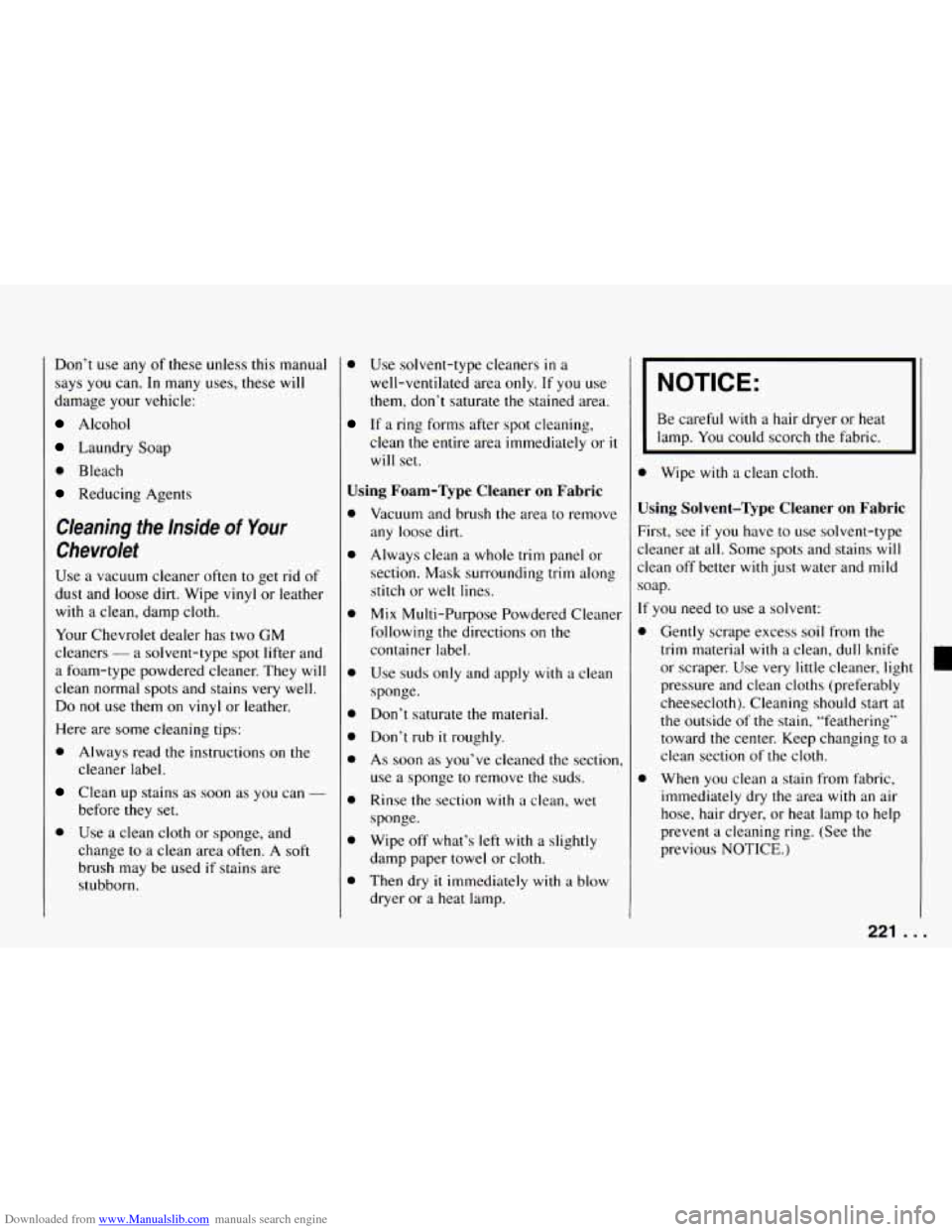
Downloaded from www.Manualslib.com manuals search engine Don’t use any of these unless this manual
says you can.
In many uses, these will
damage your vehicle:
Alcohol
Laundry Soap
0 Bleach
Reducing Agents
Cleaning the lnside of Your
Chevrolet
Use a vacuum cleaner often to get rid of
dust and loose dirt. Wipe
vinyl or leather
with a clean, damp cloth.
Your Chevrolet dealer has two
GM
cleaners - a solvent-type spot lifter and
a foam-type powdered cleaner. They will
clean normal spots and stains
very well.
Do not use them on vinyl or leather.
Here are some cleaning tips:
0 Always read the instructions on the
Clean up stains as soon as you can -
0 Use a clean cloth or sponge, and
cleaner label.
before they
set.
change
to a clean area often. A soft
brush may be used if stains are
stubborn.
0 Use solvent-type cleaners in a
well-ventilated area only.
If you use
them, don’t saturate the stained area.
clean the
entire area immediately or it
will set.
If a ring forms after spot cleaning,
Using Foam-Type Cleaner on Fabric
Vacuum and brush the area to remove
any loose dirt.
Always clean a whole trim panel or
section.
Mask surrounding trim along
stitch or
welt lines.
Mix Multi-Purpose Powdered Cleaner
following the directions on the
container label.
Use suds only and apply
with a clean
sponge.
Don’t saturate the material.
Don’t rub
it roughly.
As soon as you’ve cleaned the section,
use a sponge to remove the suds.
Rinse the section
with a clean, wet
sponge.
Wipe off what’s left
with a slightly
damp paper towel or cloth.
Then dry
it immediately with a blow
dryer or
a heat lamp.
I NOTICE:
I
Be careful with a hair dryer or heat
lamp. You could scorch
the fabric. I
Wipe with a clean cloth.
Using Solvent-’1[Sipe Cleaner on Fabric
First, see if you have to use solvent-type
:leaner
at all. Some spots and stains will
:lean off better with just water and mild
;oap.
If you need to use a solvent:
Gently scrape excess soil from the
trim material with a clean, dull knife
or scraper. Use very little cleaner, light
pressure and clean cloths (preferably
cheesecloth). Cleaning should start at
the outside
of the stain, “feathering”
toward the center. Keep changing to a
clean section of the cloth.
When you clean
a stain from fabric,
immediately dry the area
with an air
hose, hair dryer, or heat lamp to help
prevent a cleaning ring. (See the
previous NOTICE.)
221 . . .
Page 224 of 292
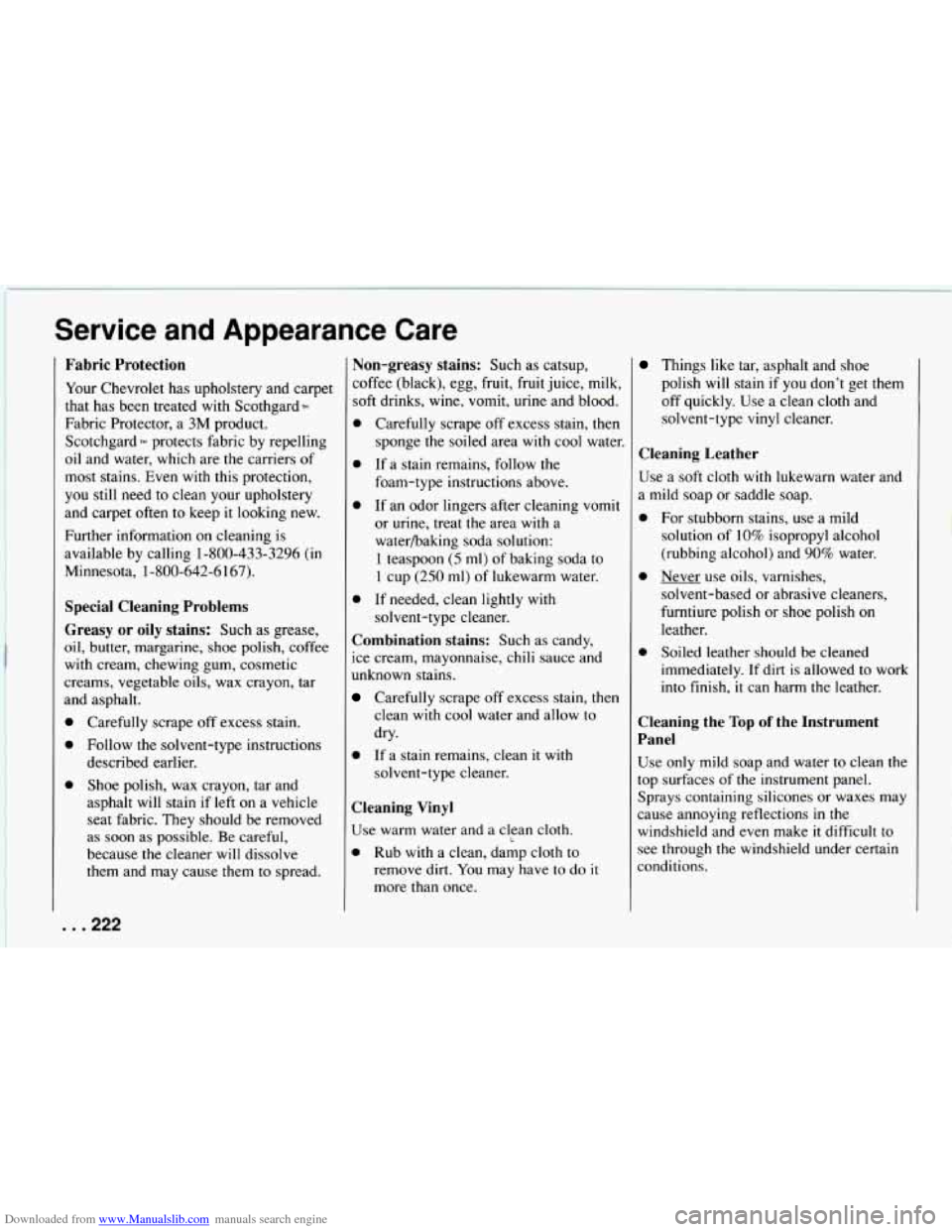
Downloaded from www.Manualslib.com manuals search engine Service and Appearance Care
Fabric Protection
Your Chevrolet has upholstery and carpet
that has been treated
with Scothgardm
Fabric Protector, a 3M product.
Scotchgard- protects fabric by repelling
oil and water, which are the carriers of
most stains. Even
with this protection,
you still need
to clean your upholstery
and carpet often to keep
it looking new.
Further information on cleaning is
available by calling 1-800-433-3296
(in
Minnesota, 1-800-642-6 167).
Special Cleaning Problems
Greasy or oily stains:
Such as grease,
oil, butter, margarine, shoe polish, coffee
with cream, chewing gum, cosmetic
creams, vegetable oils, wax crayon, tar
and asphalt.
0
0
0
Carefully scrape off excess stain.
Follow the solvent-type instructions
described earlier.
Shoe polish, wax crayon, tar and
asphalt
will stain if left on a vehicle
seat fabric. They should be removed
as soon as possible. Be careful,
because the cleaner
will dissolve
them and may cause them to spread.
Non-greasy stains: Such as catsup,
coffee (black), egg, fruit,
fruit juice, milk,
soft drinks, wine, vomit, urine and blood.
0 Carefully scrape off excess stain, then
sponge the soiled area
with cool water.
0 If a stain remains, follow the
foam-type instructions above.
or urine, treat the area
with a
waterbaking soda solution:
1 teaspoon (5 ml) of baking soda to
1 cup (250 ml) of lukewarm water.
solvent-type cleaner.
0 If an odor lingers after cleaning vomit
0 If needed, clean lightly with
Combination stains: Such as canay,
ice cream, mayonnaise, chili sauce and
unknown stains.
Carefully scrape off excess stain, then
clean
with cool water and allow to
dry.
solvent-type cleaner.
0 If a stain remains, clean it with
Cleaning Vinyl
Use warm water and a clean cloth.
0 Rub with a clean, damp cloth to
remove dirt. You may have to do
it
more than once.
Things like tar, asphalt and shoe
polish
will stain if you don’t get them
off quickly. Use a clean cloth and
solvent-type
vinyl cleaner.
Cleaning Leather
Use a soft cloth with lukewarn water and
a mild soap or saddle soap.
For stubborn stains, use a mild
solution of 10% isopropyl alcohol
(rubbing alcohol) and 90% water.
Never use oils, varnishes,
solvent-based or abrasive cleaners,
furntiure polish or shoe polish on
leather.
Soiled leather should be cleaned
immediately. If
dirt is allowed to work
into finish,
it can harm the leather.
Cleaning the Top of the Instrument
Panel
Use only mild soap and water to clean the
top surfaces of the instrument panel.
Sprays containing silicones or waxes may
cause annoying reflections
in the
windshield and even make
it difficult to
see through the windshield under certain
conditions.
. . .222
Page 225 of 292
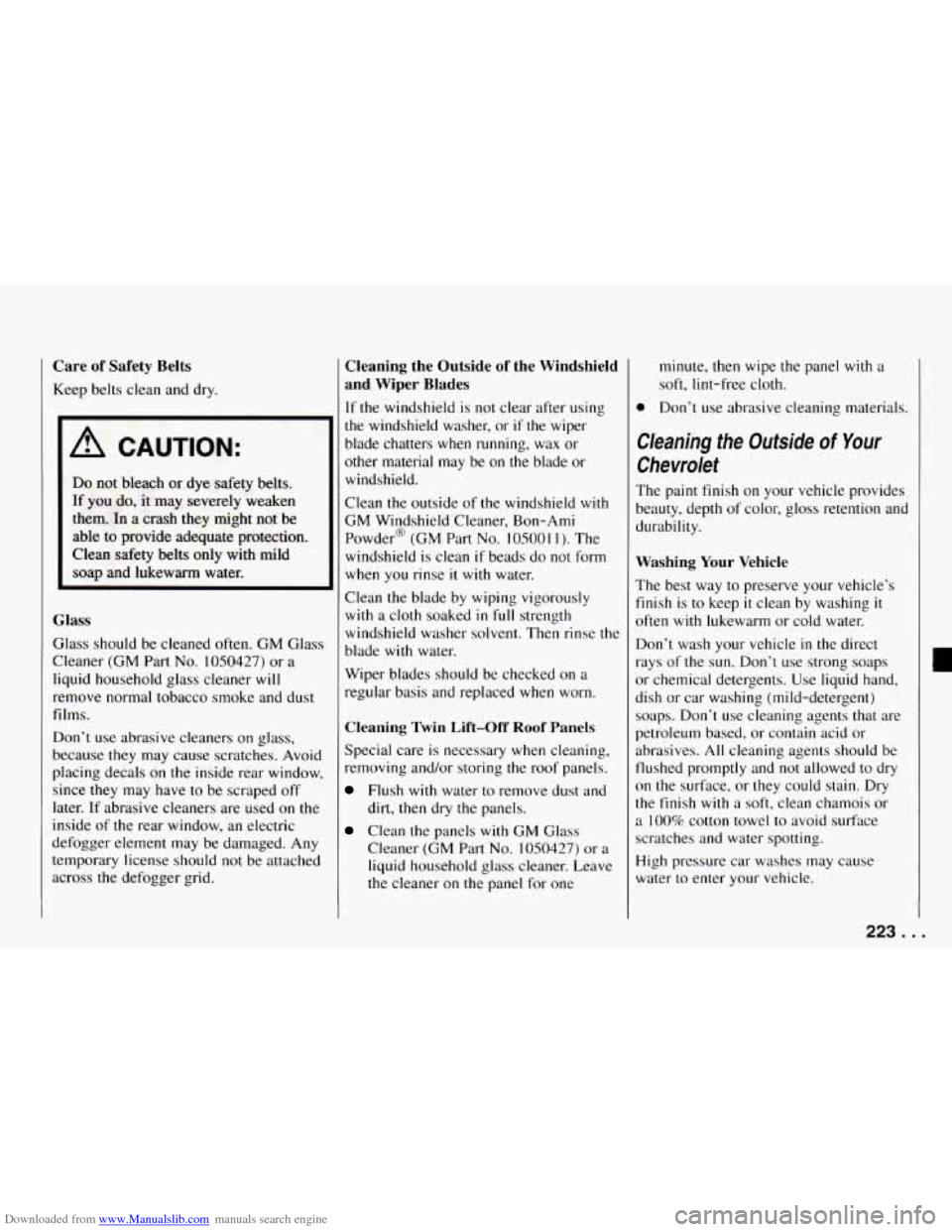
Downloaded from www.Manualslib.com manuals search engine Care of Safety Belts
Keep belts clean and dry.
A CAUTION:
Do not bleach or dye safety belts.
If YOU do, it may severely weaken
them. In a crash they might not be
able to provide adequate protection.
Clean safety belts
only with mild
soap
and lukewarm water.
Glass
Glass should be cleaned often. GM Glass
Cleaner (GM Part
No. 1050427) or a
liquid household glass cleaner will
remove normal tobacco smoke and dust
films.
Don’t use abrasive cleaners on glass,
because they may cause scratches. Avoid
placing decals on the inside rear window,
since they
may have to be scraped off
later. If abrasive cleaners are used on the
inside of the rear window, an electric
defogger element may be damaged.
Any
temporary license should not be attached
across the defogger grid.
I
Cleaning the Outside of the Windshield
and Wiper Blades
If the windshield is not clear after using
the windshield washer, or
if the wiper
blade chatters when running, wax or
other material
may be on the blade or
windshield.
Clean the outside
of the windshield with
GM Windshield Cleaner, Bon-Ami
Powder@ (GM Part
No. 10500 1 1 ). The
windshield is clean
if beads do not form
when you rinse
it with water.
Clean the blade
by wiping vigorously
with a cloth soaked in full strength
windshield washer solvent. Then rinse the
blade with water.
Wiper blades should be checked on a
regular basis and replaced when worn.
Cleaning Twin Lift-off Roof Panels
Special care is necessary when cleaning,
removing and/or storing the roof panels.
Flush with water to remove dust and
dirt, then dry the panels.
Cleaner
(GM Part No. 1050427) or a
liquid household glass cleaner. Leave
the cleaner on the panel for one
Clean the panels with GM Glass minute,
then wipe the panel
with a
soft, lint-free cloth.
0 Don’t use abrasive cleaning materials.
Cleaning the Outside of Your
Chevrolet
The paint finish on your vehicle provides
beauty, depth of color, gloss retention and
durability.
Washing Your Vehicle
The best way to preserve your vehicle’s
finish is to keep
it clean by washing it
often with lukewarm or cold water.
Don’t wash your vehicle
in the direct
rays of the sun. Don’t use strong soaps
or chemical detergents. Use liquid hand,
dish
or car washing (mild-detergent)
soaps. Don’t use cleaning agents that are
petroleum based, or contain acid or
abrasives.
All cleaning agents should be
flushed promptly and not allowed to
dry
on the surface, or they could stain. Dry
the finish
with a soft, clean chamois or
a
100% cotton towel to avoid surface
scratches and water spotting.
High pressure car washes may cause
water to enter your vehicle.
223 .
Page 226 of 292
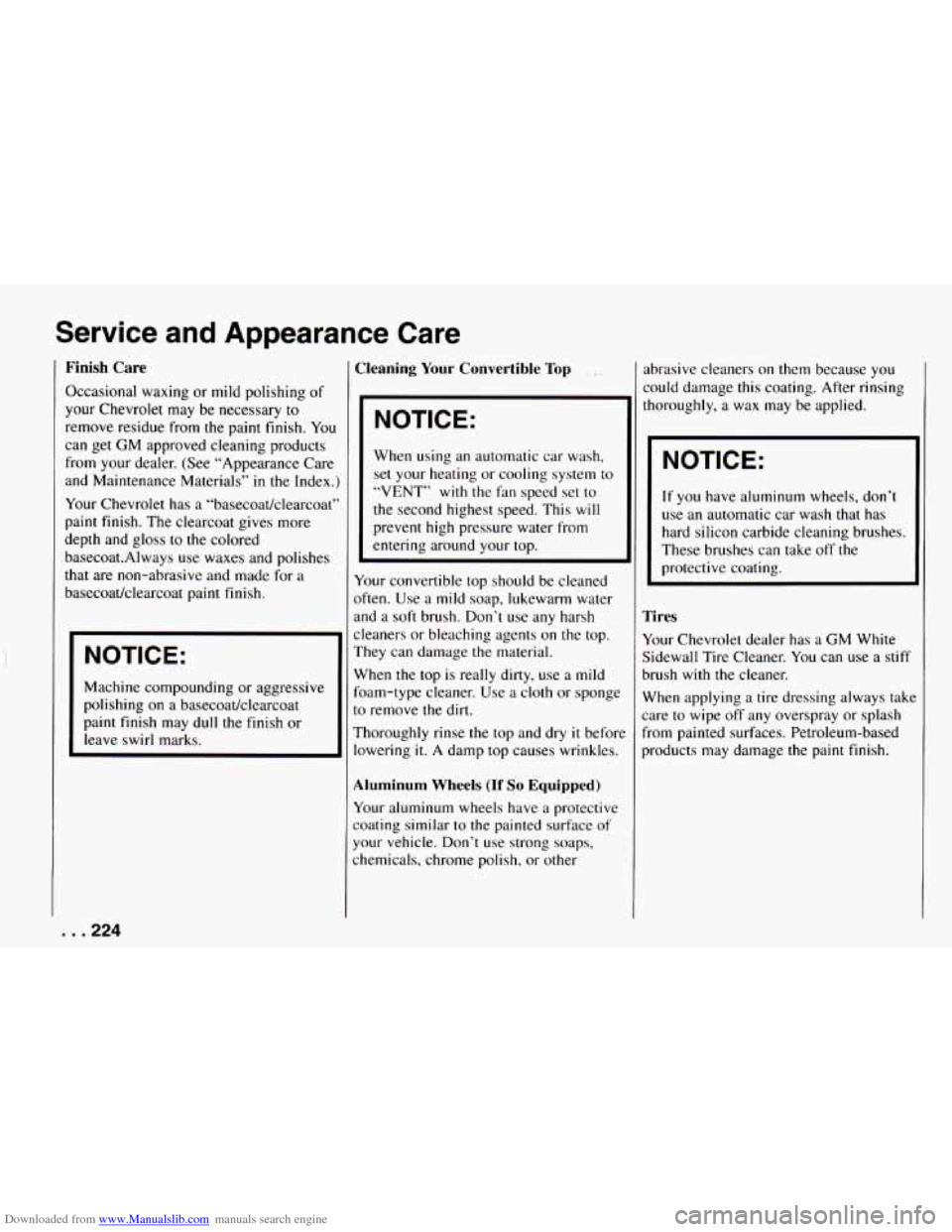
Downloaded from www.Manualslib.com manuals search engine Service and Appearance Care
1 Finish Care
Occasional waxing or mild polishing of
your Chevrolet may be necessary to
remove residue from the paint finish.
You
can get GM approved cleaning products
from your dealer. (See “Appearance Care
and Maintenance Materials”
in the Index.)
Your Chevrolet has a “basecoat/clearcoat”
paint finish. The clearcoat gives more
depth and gloss to the colored
basecoat.Always use waxes and polishes
that are non-abrasive and made for a
basecoatklearcoat paint finish.
NOTICE:
Machine compounding or aggressive
polishing on a basecoatklearcoat
paint finish may
dull the finish or
leave swirl marks.
. . .224
Cleaning Your Convertible Top
NOTICE:
When using an automatic car wash,
set your heating or cooling system to
“VENT”
with the fan speed set to
the second highest speed. This
will
prevent high pressure water from
entering around your top.
Your convertible top should be cleaned
often. Use
a mild soap, lukewarm water
and a soft brush. Don’t use any harsh
cleaners or bleaching agents on the top.
They can damage the material.
When the top is really dirty, use a
mild
foam-type cleaner. Use a cloth or sponge
to remove the dirt.
Thoroughly rinse the top and dry
it before
lowering
it. A damp top causes wrinkles.
Aluminum Wheels (If So Equipped)
Your aluminum wheels have a protective
coating similar to the painted surface
of
your vehicle. Don’t use strong soaps,
chemicals, chrome polish, or other abrasive cleaners
on them because
you
could damage this coating. After rinsing
thoroughly, a wax may be applied.
NOTICE:
If you have aluminum wheels, don’t
use an automatic car wash that has
hard silicon carbide cleaning brushes.
These brushes can take off the
protective coating.
Tires
Your Chevrolet dealer has a GM White
Sidewall Tire Cleaner.
You can use a stiff
brush
with the cleaner.
When applying a tire dressing always takt
care to wipe off any overspray or splash
from painted surfaces. Petroleum-based
products may damage the paint finish.
Page 227 of 292
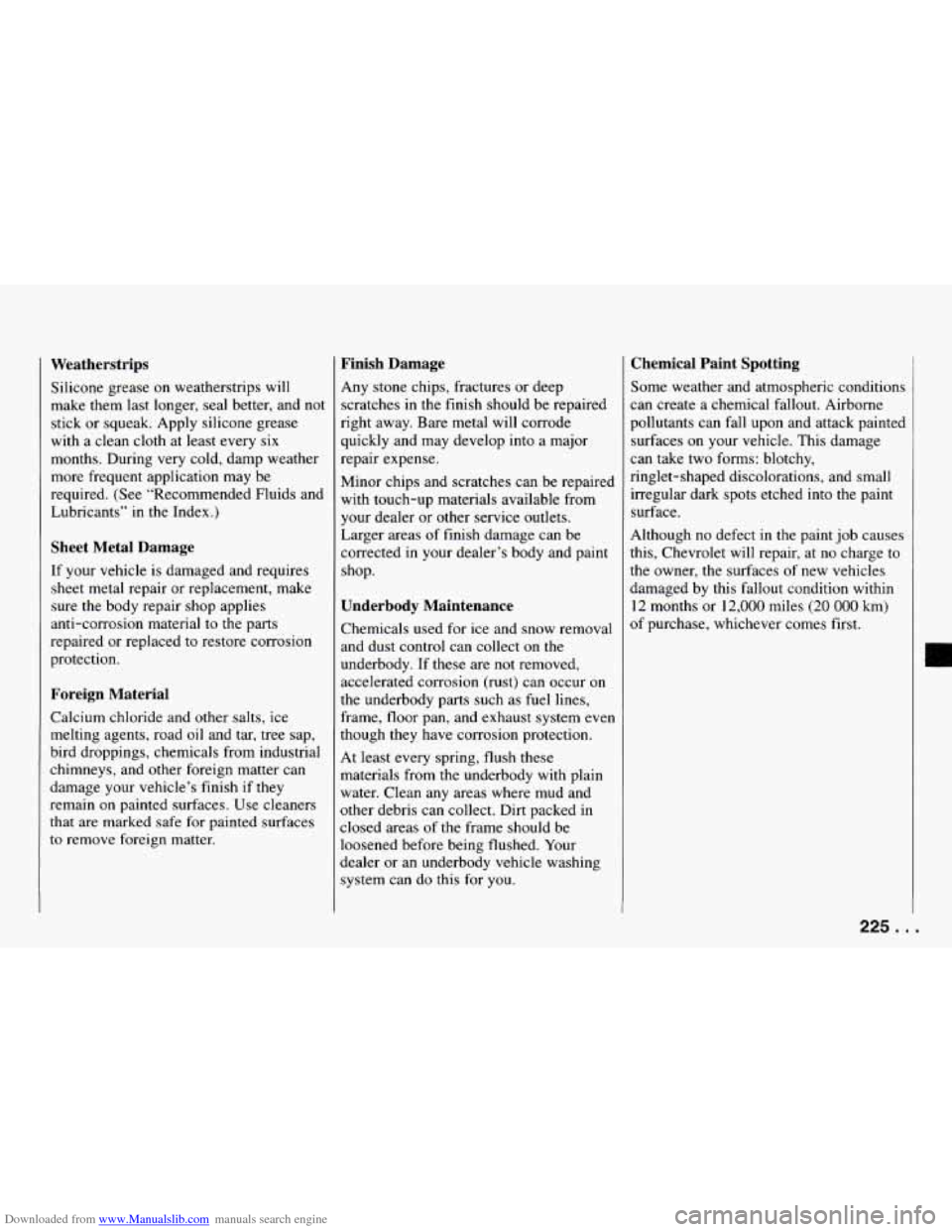
Downloaded from www.Manualslib.com manuals search engine Weatherstrips
Silicone grease on weatherstrips will
make them last longer, seal better, and not
stick or squeak. Apply silicone grease
with a clean cloth at least every six
months. During very cold, damp weather
more frequent application may be
required. (See “Recommended Fluids and
Lubricants” in the Index.)
Sheet Metal Damage
If your vehicle is damaged and requires
sheet metal repair or replacement, make
sure the body repair shop applies
anti-corrosion material to the parts
repaired or replaced to restore corrosion
protection.
Foreign Material
Calcium chloride and other salts, ice
melting agents, road oil and tar, tree sap,
bird droppings, chemicals from industrial
chimneys, and other foreign matter can
damage your vehicle’s finish
if they
remain on painted surfaces. Use cleaners
that are marked safe for painted surfaces
to remove foreign matter.
Finish Damage
Any stone chips, fractures or deep
scratches in the finish should be repaired
right away. Bare metal will corrode
quickly and may develop into a major
repair expense.
Minor chips and scratches can be repaired
with touch-up materials available from
your dealer or other service outlets.
Larger areas of finish damage can be
corrected in your dealer’s body and paint
shop.
Underbody Maintenance
Chemicals used for ice and snow removal
and dust control can collect on the
underbody. If these are not removed,
accelerated corrosion (rust) can occur on
the underbody parts such as fuel lines,
frame, floor pan, and exhaust system even
though they have corrosion protection.
At least every spring, flush these
materials from the underbody with plain
water. Clean any areas where mud and
other debris can collect. Dirt packed in
closed areas of the frame should be
loosened before being flushed. Your
dealer or an underbody vehicle washing
system can do this for you.
Chemical Paint Spotting
Some weather and atmospheric conditions
can create a chemical fallout. Airborne
pollutants can fall upon and attack painted
surfaces on your vehicle. This damage
can take two forms: blotchy,
ringlet-shaped discolorations, and small
irregular dark spots etched into the paint
surface.
Although no defect in the paint job causes
this, Chevrolet will repair, at no charge to
the owner, the surfaces of new vehicles
damaged by this fallout condition within
12 months or 12,000 miles (20 000 km)
of purchase, whichever comes first.
225. . .
Page 228 of 292
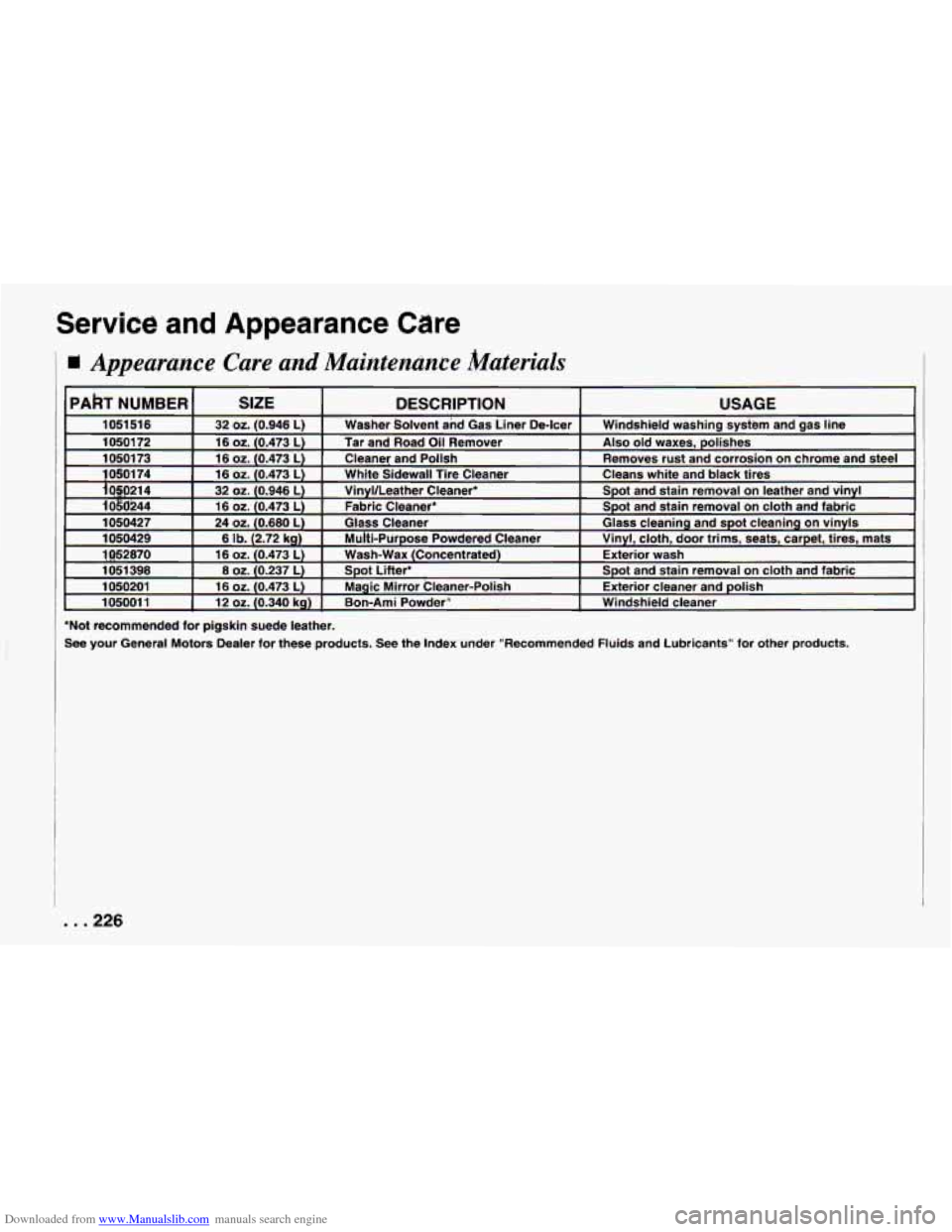
Downloaded from www.Manualslib.com manuals search engine Service and Appearance Care
I Appearance Care and Maintenance Materials
PART NUMBER SIZE DESCRIPTION USAGE
1051516 32 02. (0.946 L) Washer gotvent and Gas
Liner De-lcer Windshield
washing system and gas line
10501
72 16 02. (0.473 L) Tar and Road Oil Remover
Also old waxes, polishes c
*Not recommended for pigskin suede leather.
See your General Motors Dealer for these products. See the Index under "Recommended Fluids and Lubricants" for other products.
. . .226
Page 229 of 292
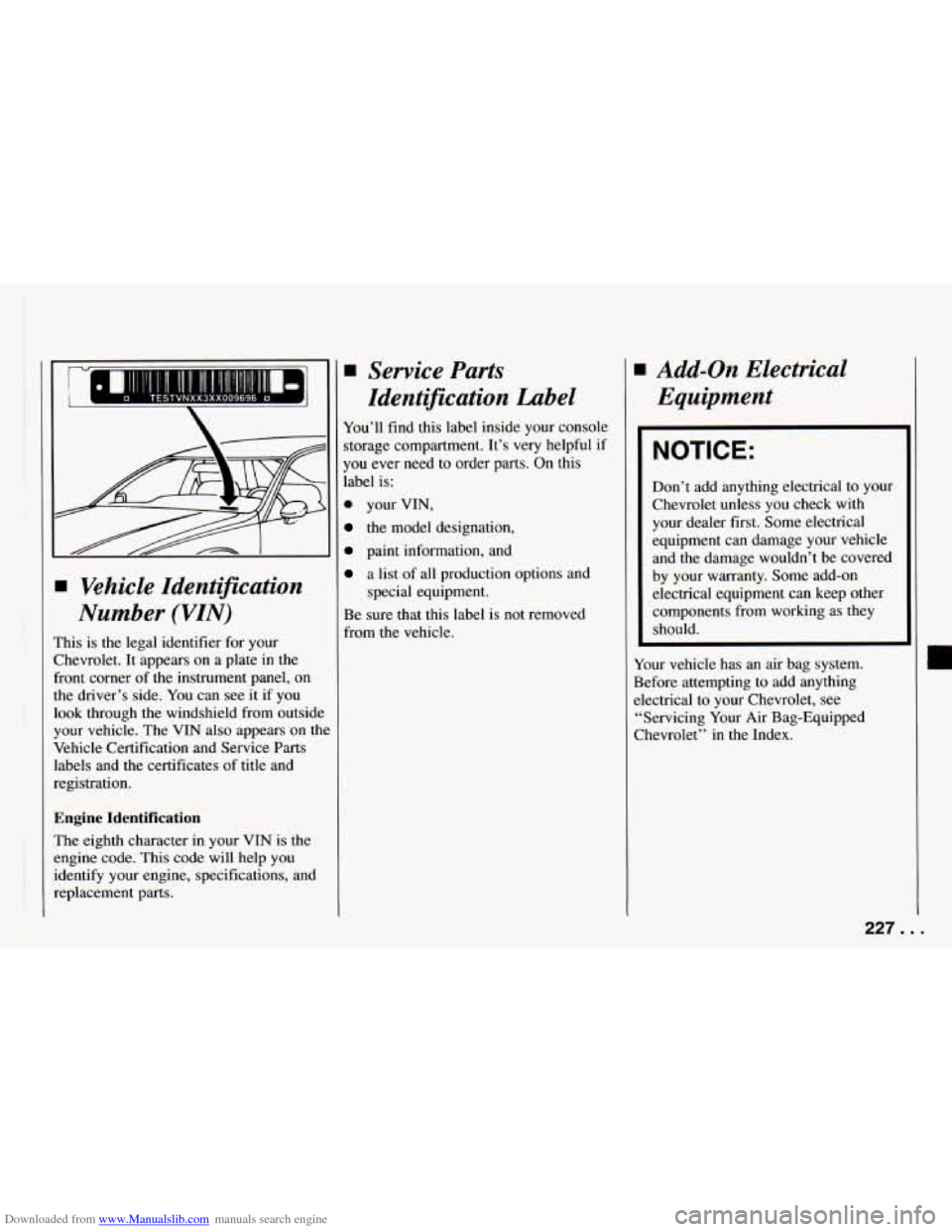
Downloaded from www.Manualslib.com manuals search engine I
w Vehicle Identification
Number (VIN)
This is the legal identifier for your
Chevrolet. It appears on a plate in the
front corner of the instrument panel, on
the driver’s side. You can see it if you
look through the windshield from outside
your vehicle. The VIN also appears on the
Vehicle Certification and Service Parts
labels and the certificates of title and
registration.
Engine Identification
The eighth character in your VIN is the
engine code. This code will help you
identify your engine, specifications, and
replacement parts.
Service Parts
Identification Label
You’ll find this label inside your console
itorage compartment. It’s very helpful if
you ever need to order parts. On this
label is:
D your VIN,
the model designation,
paint information, and
a list of all production options anc
special equipment.
Be sure that this label is not removed
From the vehicle.
Add-on Electrical
Equipment
NOTICE:
Don’t add anything electrical to your
Chevrolet unless
you check with
your dealer first. Some electrical
equipment can damage your vehicle
and the damage wouldn’t be covered
by your warranty. Some add-on
electrical equipment can keep other
components from working as they
should.
Your vehicle has an air bag system.
Before attempting to add anything
electrical to your Chevrolet, see
“Servicing Your Air Bag-Equipped
Chevrolet” in the Index.
227. . .
Page 230 of 292
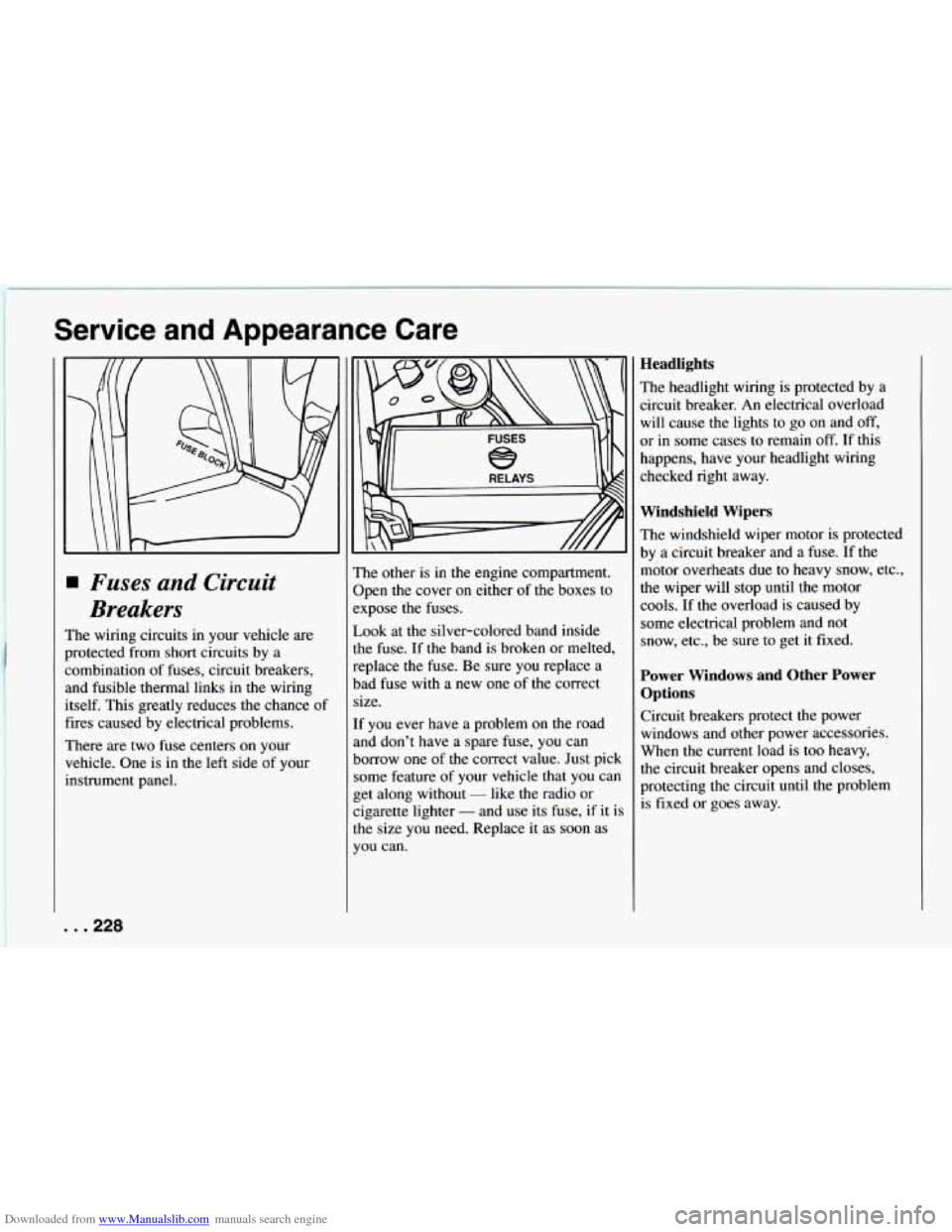
Downloaded from www.Manualslib.com manuals search engine Service and Appearance Care
Fuses and Circuit
Breakers
The wiring circuits in your vehicle are
protected from short circuits by a
combination of fuses, circuit breakers,
and fusible thermal links in the wiring
itself. This greatly reduces the chance of
fires caused by electrical problems.
There are two fuse centers on your
vehicle. One is in the left side of your
instrument panel. The other
is in the engine compartment.
Open the cover on either of the boxes to
expose
the fuses.
Look at the silver-colored band inside
the fuse.
If the band is broken or melted,
replace the fuse. Be sure you replace a
bad fuse
with a new one of the correct
size.
If you ever have a problem on the road
and don’t have a spare fuse, you can
borrow one of the correct value. Just pick
some feature of your vehicle that you car
get along without
- like the radio or
cigarette lighter
- and use its fuse, if it i
the size you need. Replace it as soon as
you can.
Headlights
The headlight wiring is protected by a
circuit breaker. An electrical overload
will cause the lights to go on and off,
or
in some cases to remain off. If this
happens, have your headlight wiring
checked right away.
Windshield Wipers
The windshield wiper motor is protected
by a circuit breaker and a fuse. If the
motor overheats due to heavy snow, etc.,
the wiper will stop until the motor
cools. If the overload is caused by
some electrical problem and not
snow, etc., be sure to get it fixed.
Power Windows and Other Power
Options
Circuit breakers protect the power
windows and other power accessories.
When the current load is too heavy,
the circuit breaker opens and closes,
protecting the circuit until the problem
is fixed or goes away.
. . .228